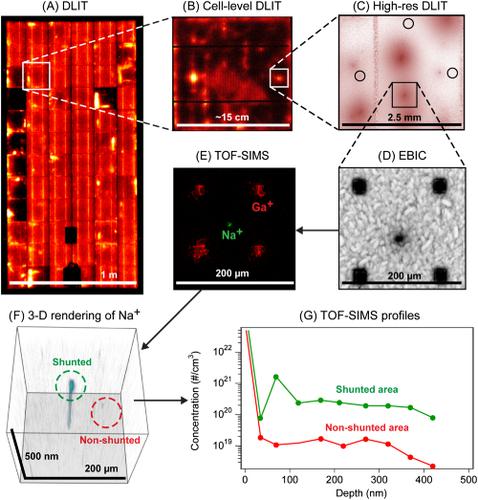当前位置:
X-MOL 学术
›
Prog. Photovoltaics
›
论文详情
Our official English website, www.x-mol.net, welcomes your feedback! (Note: you will need to create a separate account there.)
Investigating PID shunting in polycrystalline silicon modules via multiscale, multitechnique characterization
Progress in Photovoltaics ( IF 6.7 ) Pub Date : 2018-02-27 , DOI: 10.1002/pip.2996 Steven P. Harvey 1 , John Moseley 1 , Andrew Norman 1 , Adam Stokes 2 , Brian Gorman 2 , Peter Hacke 1 , Steve Johnston 1 , Mowafak Al-Jassim 1
Progress in Photovoltaics ( IF 6.7 ) Pub Date : 2018-02-27 , DOI: 10.1002/pip.2996 Steven P. Harvey 1 , John Moseley 1 , Andrew Norman 1 , Adam Stokes 2 , Brian Gorman 2 , Peter Hacke 1 , Steve Johnston 1 , Mowafak Al-Jassim 1
Affiliation

|
We investigated the potential‐induced degradation (PID) shunting mechanism in multicrystalline‐silicon photovoltaic modules by using a multiscale, multitechnique characterization approach. Both field‐stressed modules and laboratory‐stressed mini modules were studied. We used photoluminescence, electroluminescence, and dark lock‐in thermography imaging to identify degraded areas at the module scale. Small samples were then removed from degraded areas, laser marked, and imaged by scanning electron microscopy. We used simultaneous electron‐beam induced current imaging and focused ion beam milling to mark around PID shunts for chemical analysis by time‐of‐flight secondary‐ion mass spectrometry or to isolate individual shunt defects for transmission electron microscopy and atom‐probe tomography analysis. By spanning a range of 10 orders of magnitude in size, this approach enabled us to investigate the root‐cause mechanisms for PID shunting. We observed a direct correlation between recombination active shunts and sodium content. The sodium content in shunted areas peaks at the SiNX/Si interface and is consistently observed at a concentration of 0.1% to 2% in shunted areas. Analysis of samples subjected to PID recovery, either activated by electron beam or thermal effects only, reveals that recovery of isolated shunts correlates with diffusion of sodium out of the structural defects to the silicon surface. We observed the role of oxygen and chlorine in PID shunting and found that those species—although sometimes present in structural defects where PID shunting was observed—do not play a consistent role in PID shunting.
中文翻译:

通过多尺度,多种技术表征研究多晶硅模块中的PID分流
我们使用多尺度,多种技术的表征方法研究了多晶硅光伏组件中的电势退化(PID)分流机制。研究了现场受力模块和实验室受力迷你模块。我们使用光致发光,电致发光和暗锁定热成像技术来识别模块规模上的退化区域。然后从降解区域中取出小样品,进行激光打标,并通过扫描电子显微镜成像。我们使用同步电子束感应电流成像和聚焦离子束铣削来标记PID分流器周围,以通过飞行时间二次离子质谱法进行化学分析,或隔离单个分流器缺陷以进行透射电子显微镜和原子探针层析成像分析。通过跨越10个数量级的范围,此方法使我们能够研究PID分流的根本原因机制。我们观察到重组活性分流器与钠含量之间存在直接关系。分流区域的钠含量在SiN达到峰值X / Si界面,并在分流区域始终观察到浓度为0.1%至2%。通过仅通过电子束或热效应激活的PID恢复样品的分析表明,孤立分流的恢复与钠从结构缺陷扩散到硅表面有关。我们观察了氧气和氯气在PID分流中的作用,发现这些物种(尽管有时存在于观察到PID分流的结构缺陷中)在PID分流中没有发挥一致的作用。
更新日期:2018-02-27
中文翻译:

通过多尺度,多种技术表征研究多晶硅模块中的PID分流
我们使用多尺度,多种技术的表征方法研究了多晶硅光伏组件中的电势退化(PID)分流机制。研究了现场受力模块和实验室受力迷你模块。我们使用光致发光,电致发光和暗锁定热成像技术来识别模块规模上的退化区域。然后从降解区域中取出小样品,进行激光打标,并通过扫描电子显微镜成像。我们使用同步电子束感应电流成像和聚焦离子束铣削来标记PID分流器周围,以通过飞行时间二次离子质谱法进行化学分析,或隔离单个分流器缺陷以进行透射电子显微镜和原子探针层析成像分析。通过跨越10个数量级的范围,此方法使我们能够研究PID分流的根本原因机制。我们观察到重组活性分流器与钠含量之间存在直接关系。分流区域的钠含量在SiN达到峰值X / Si界面,并在分流区域始终观察到浓度为0.1%至2%。通过仅通过电子束或热效应激活的PID恢复样品的分析表明,孤立分流的恢复与钠从结构缺陷扩散到硅表面有关。我们观察了氧气和氯气在PID分流中的作用,发现这些物种(尽管有时存在于观察到PID分流的结构缺陷中)在PID分流中没有发挥一致的作用。



























 京公网安备 11010802027423号
京公网安备 11010802027423号